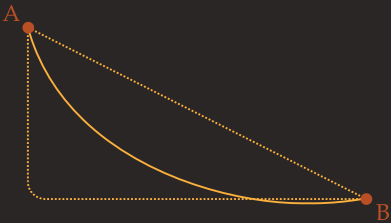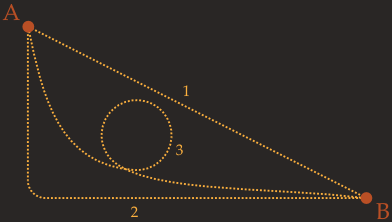What path should a particle take such that it moves from point A to B in the least time under the force of gravity?
Is it path 1, where we stick the particle on a straight ramp and allow it to accelerate at a constant rate? Is it path 2, where we drop the particle on a death slide, allowing it to reach high speed before flinging it straight towards B on a horizontal path? Or is it something funny like 3?
The answer is ‘something funny’ (not as funny as a loop, though), and the derivation of the form of the path is going to take some thinking about.
We’re going to use the Euler-Lagrange equations to minimise the functional , the time taken for the particle to go from A to B as a function of the path parametrised by
.
To calculate , we’re going to break down the particle’s journey into very many tiny intervals, during each of which the particle travels an infinitesimal distance
. The time taken to traverse this tiny distance is
. These two differentials are related by the equation
where is the speed of the particle during the interval.
The goal is to find an expression for in terms of
and its derivatives, where
is the height of the particle above ‘the ground’. Let’s first tackle
.
From Pythagoras’ theorem, this distance is related to small changes in and
by
hence
What about ? Assuming the particle experiences no dissipative forces, we can use the conservation of energy to calculate
in terms of
. If the particle starts at height
above the ground, and the ground is taken to be the level at which the particle’s gravitational potential energy is 0, then
Plastering this all together, we have
The total time taken for the particle to traverse the path is just the sum of all these differentials:
To find the function that minimises this integral, we can use the Euler-Lagrange equation, which in its raw form says that
where is the Lagrangian, the integrand of the functional. So in this case,
where we’re ignoring the constant factor outside the integral. But since this function does not explicitly contain the independent variable , we can use Beltrami’s identity which allows us to integrate once for free! After doing so, we end up with
where is some constant. This expression gives us
which, after some fiddling, says
So it comes down to solving this first-order differential equation. Fortunately it is separable and so can be integrated directly:
Here our old friend accomplice integration by substitution makes an appearance, and today she’s in a trigonometric mood:
Substitution gives
We can use the half-angle formula to replace the sine squared:
For convenience we’ll redefine some quantities:
Hence
Without loss of generality, we can define such that
is zero when
is zero. This makes the constant
disappear:
Remember also the expression for in terms of
, which can be rearranged to give
Ideally, we want to write this in terms of , so we use the half-angle formula we used before to give
hence
So there’s our solution:
The curve this vector parametrically describes is a cycloid. We met this shape in an earlier post in completely different circumstances! The value of the constant is determined by the relative positions of points A and B.
 Here’s a comparison of the cycloid (the solid line) with the straight line and the ‘step’ path. What does the cycloid have that the other two paths do not?
Here’s a comparison of the cycloid (the solid line) with the straight line and the ‘step’ path. What does the cycloid have that the other two paths do not?
First consider the straight line. The straight line is clearly the shortest path the particle could take. But this doesn’t make it the quickest to traverse; the gradient of the path is small, so the particle accelerates relatively slowly. This means its mean speed over the course of its descent is small.
What about the death slide path? This gets the particle up to maximum speed as quickly as possible. But now we’ve overcompensated – the particle’s path is now unnecessarily long. The extra speed we gain is wasted by our having to travel further!
The cycloid represents a compromise. Along this path, the particle accelerates moderately quickly and travels a moderate distance, and in doing so reaches its endpoint in the least time.
What is surprising (to me at least) is that, even though the endpoint is an appreciable distance below the startpoint, the particle actually spends part of its journey ascending. The diagram shows that, towards the end of the path, the particle rises (and consequently decelerates) to meet the endpoint.
In a following post we’ll look at a similar problem in the context of geometric optics. It’s almost as fun as it sounds!
